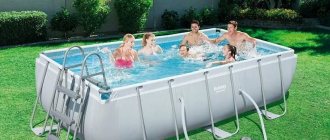How to find a hole in a swimming pool
When starting repairs, the first thing you need to do is determine the location of the defect. You need to understand that there are two types of pools: frame and inflatable. In each of them, a hole is found in different ways. Let's look at the process in detail.
Inflatable pools are easy to use, made of durable polymer, but are subject to punctures: by a stone, by spikes, by a cat or dog jumping, etc.
Frame construction
If you suspect damage, check that water leakage is not due to evaporation that occurs naturally.
- Mark the water level on the wall of the pool;
- Fill a small basin with water and also make a mark;
- After a day, compare the water level. If it has decreased by the same distance both in the pool and in the basin, then the reason for the decrease in water is natural evaporation.
You need to know what to use in such a situation to avoid the structure blowing away and water leaking.
If the water level in the pool has dropped more significantly than in the basin, then you need to start looking for a leak.
It is possible that the water is not leaking because there is a hole, but there may be a problem with the valve aimed at blocking the water from leaving the structure. If the gasket in the drain hole is not sealed, water will naturally leak out.
Sealing is acceptable at home if the location of the water leak is determined and it is slightly damaged.
To find a hole in the bottom, pay attention to whether particles of debris, possibly earth, have collected somewhere in one place. If there is a leak, then particles will collect in this place that cannot pass through the hole, but were brought to this place by the current.
First you need to find the puncture site; this can be done using a stream of water directed at the surface or washed with soap foam.
To make it easier to find the hole, start draining the water and add dye to it. For example, special dyes are often used for temporary coloring in fountains, spas and swimming pools). This will make leaks easier to find.
If, when damage is discovered, there is nothing to repair, then you can temporarily seal the inflatable pool with improvised material: adhesive tape, tape.
Don't be afraid to drain the water. When you find a problem area, to seal it, you need the material to be dry and grease-free.
Inflatable structure
In inflatable structures, leaks are easier to find. It is impossible not to notice a large hole, but small ones are more difficult to detect.
Before sealing a frame pool at home, you need to identify the location of the defect.
Option 1. Inflate the pool and apply gentle pressure as you move around the perimeter. The torn area will emit a kind of whistle as air under pressure comes out of it.
Option 2. Also inflate the pool and press it with a wet hand. With a wet hand you will immediately feel the air flow.
Option 3. The easiest. Inflate the pool and arm yourself with soapy water and a sponge (use for washing dishes) or a spray bottle. Apply a soap solution with a lot of foam to the surface. Where the big bubbles begin to inflate is what we are looking for.
Bubbles will appear at the puncture site. Wipe and mark this place. Then immediately begin gluing.
If you find a hole, mark it with a felt-tip pen, marker, or glue something next to it so you don’t lose it again.
Procedure
First, you need to check for leaks on the filters, pump, heater and tube valve. Are there wet areas around the pool? Pay attention to wet soil or sunken and damaged areas. If the base has vinyl paint, be sure to look for cracks or grout around all mounting hardware, skimmers, returns, lamps, steps and corners.
The leak may be in the pool bowl or its water circulation systems
Pool sealing products
Modern swimming pools are made of PVC (polyvinyl chloride) material. The material is very durable and holds its shape well. The pool is unlikely to suddenly burst, but piercing the material with a sharp object will not be difficult.
Be sure to buy waterproof glue, since the patch will constantly come into contact with water.
Pools can be glued in different ways, mainly using different types of waterproof glue. But other methods also exist:
- Plaster or tape. The measure is temporary and fragile. But serious repairs can last for several hours, or at most one day.
- Special repair kit. A very useful thing. The kit includes: glue and a patch, sometimes the kit has additional tools.
- Waterproof glue. Ideal for gluing PVC materials. Resistant to water.
- There is a convenient solution called liquid patch. It is a liquid PVC that dries in 10 minutes.
At home, pools are sealed using a special waterproof glue.
You can always contact a car service or other service centers where they can vulcanize the defect.
Looking for a leak
How to find a hole? When searching for leaks, it is rational to use paint pigment. A similar drug is used for testing swimming pools and hydraulic systems. This component leaves a mark in the place where there is a water leak.
- A leaking bowl is a problematic place to find a leak. The first step when looking for a leak is to check the drain valve. Often the valve simply wears out, which leads to microcracks.
- If there is a hole at the bottom of the pool, the search begins from places where dirt accumulates. This is due to the small size of the hole through which water passes but silt does not.
To carry out quality repair work, it is necessary to completely drain the water from the pool.
High-quality repair work requires a full examination of the dry pool, and the patch should be applied exclusively to a dry surface.
How to seal a pool at home
There are several methods that are suitable for eliminating defects in both frame and inflatable tanks. Let's look at them first.
When choosing an adhesive mixture, the packaging should indicate the ability to use it with a polymer.
Using a special repair kit, you can seal the hole as follows.
- You need to cut two parts from the patch. One is small, evenly covering the edges of the hole, and the second will be needed for the second layer, and its size should be several millimeters larger than the smaller patch.
- Apply a very thin layer of glue first to the area around the hole and then to the smaller patch. All that remains is to glue the patch and the damaged area.
- Carefully glue the patch, smoothing all the edges. Place under a press for a few minutes.
Before use, read the instructions, as each type has its own application characteristics.
Note! Repair kits are included with the product upon purchase. Therefore, owners of products of this brand will not have to choose a repair method for themselves. The most convenient repair option will already be in his hands.
If you decide to repair the pool yourself using water-repellent glue, then use the following method.
When using this glue, the surface remains in working condition for a long time. It can be folded and re-inflated.
When purchasing glue, make sure that the glue contains polyvinyl chloride, due to which the glue becomes moisture resistant.
- After finding the hole, sand the area around the hole with sandpaper. The goal is to make the surface a little more uneven and rough so that the bookmark and the damaged area adhere better.
- Degrease the surface area you need.
- Apply a thin layer of adhesive to the patch and to the surface of the pool. Do this very carefully so that the glue does not extend beyond the patch. Otherwise, some other parts may stick to the pool, and if you peel them off later, you may damage the rubberized surface again.
- A press may not be needed. The glue dries in a few minutes.
Many adhesives are flammable, so do not use near an open flame source.
“Liquid patch” is applied as follows:
- Degrease the area around the damage.
- Carefully pour in the liquid patch.
- Leave for 10 minutes until completely dry.
- Apply a second coat. Let it dry.
The color of the liquid patch can be matched to the color of the product.
Small cracks can be sealed with a special sealant used specifically to restore the functionality of the pool.
After the repair is completed, you need to check whether everything went well. To do this, apply a soapy foam solution to the repaired surface and press on the pool. If bubbles begin to appear, it means that for some reason it was not possible to properly seal the defect. Repeat the procedure again.
If you find a hole in the inflatable pool, you can seal it and continue to use it.
Inflatable
All of the above methods will help eliminate damage to the inflatable product. But this type of pool has its own specifics; they sometimes tear along the seams. Let's look at how this defect can be eliminated.
You can delay pool repairs further if you first treat the defect area with an alcohol solution and clean the area a little with sandpaper.
Isolate the damaged area from water. Degrease (with alcohol, vinegar, but not solvent), coat the two sides adjacent to the seam well with glue, and tightly connect them with pressure. Leave in this position for a day.
Frame
A frame pool can also be easily sealed using all of the methods listed above. And only one temporary measure cannot be applied to an inflatable structure, but only to a frame structure.
For repairs, special kits are produced, which include a PVC patch and a small tube of special glue.
How to seal a pool with tape or plaster? It is not possible to seal an inflatable pool with tape, but a frame pool, due to its rigid structure, can be temporarily adjusted using this method.
- Determine where the damaged area is.
- Mark the puncture site with a marker.
- Wipe the area near the hole dry and degrease. You can degrease with ordinary ethyl alcohol, cologne, acetone, solvent - whatever you have on hand.
- Apply tape.
The best option to determine a leak is to completely drain the water.
PVC
PVC pools should not be repaired using superglue as it is not compatible with PVC material. Using superglue can make the problem even worse.
Common Causes of Leakage
The most common problems arise from the separation of plastic overflow and concrete. This can be easily fixed with putty.
Leaks on lamps are often caused by the cable housing dissolving. This is difficult to fix, but there are various methods for sealing a bad cable connection. Two-part epoxy glue, with plaster, silicone or sealant are ways to solve the problem. Simply stick them on using a vinyl patch kit.
Many leaks may not be found using the methods described above. Then it's time to call a professional. Thanks to modern technology, most pool problems can be found and repaired without any major construction work. These methods include: compressed air pressure. The air displaces the water in the pipe until it reaches a leak, at which point air bubbles come out of the pipe and expose the problem area. A special video camera is inserted into the tube, blowing air into the tube and then scanning the sounds electronically using a sensitive microphone.
How the verification system works
The basic configuration of the pool control and filter system is simple. Water is drawn in through the overflow and pumped through the pump. It flows underground back to the mechanical location where it passes through the pump's screen basket and then is forced through a filter.
In addition to these closed system lines, there are several other aspects of the piping system that do not operate in a closed (pressurized) system.
Most pools have an open system (due to gravity rather than pressure) which helps the pool pump continue to maintain its level during low water levels. This expansion line is often forgotten or ignored during repairs because replacement is costly and time consuming.
Article on the topic: Okhta Park swimming pool how to get there
The balance line is connected to the bottom of the overflow and the other end to either the main end or a side port in the pool wall next to the overflow. This is the pipe leading from the bottom of the overflow down to the main drains, which are often overlooked. Because it is a non-pressurized line, it leaks less than a pressure line, but it may also be older than the rest of the pool lines, so it will likely be a candidate for unexplained water loss.
Sealing a swimming pool underwater
If your pool is very large and draining all the water is simply not possible at the moment, but you find a hole under water, then there is a temporary emergency measure. Placement of patches outside and inside. Purchase an adhesive repair kit from a sporting goods store. The composition includes adhesive tape, one side of which is coated with water-repellent glue.
It is possible to seal the damage without draining the water. To do this, you need a special kit containing material for use under water and on the outside, and a sealant.
Important! First you need to stick the required size of tape inside the pool to stop the flow of water. And then from the outside
Verification methods
Stage 1
You need to mark the water level with a marker or a piece of adhesive tape. Check labeling after 24 hours. Water should not drain more than 6 mm per day.
Stage 2
Place a bucket filled with water on the step, or place a stone inside. Mark the water level both inside and outside the bucket. Make sure the water in the bucket is as high as the water outside the bucket. Check labeling after 24 hours. If the line outside the bucket is significantly higher than the water, then the seal of the bowl is broken.
This test should be performed with the pump on and then again with the pump off.
Stage 3
If a leak is detected, you need to turn on the filtration system and pay attention to where the water no longer falls. The base with vinyl insert must always be filled with water.
Article on the topic: Is it possible to swim in a pool with a liner?
If it stops below the overflow hole, it is likely in an overflow or filter system (including pipes).
If it remains in the fixtures, there may be a break during draining at the bottom of the pool.
If air bubbles are visible in the return line water when the pump is running, there is a problem with the inlet side of the filtration system. You need to check whether the cover's O-ring is lubricated. Check the start or flush line for cracks, play or breakage.
Repair of swimming pools Intex
Now let's look at how to seal an Intex pool at home. Intex brand tanks are made of polyvinyl chloride or rubberized material. When purchasing an Intex product, a repair kit is included. If you don't have it, buy it at the store. The brand of the set corresponds to the brand of the product - Intex.
The set consists of three patches measuring 15*50 cm, PVC glue with a volume of 50 ml and two pairs of special gloves.
Almost all pools include a special sealing kit.
The procedure is:
- Drain the water tank. Wipe the damaged area dry.
- A section of the required size is cut out of the patch. The cut patch should extend beyond the damage on all sides by approximately 2 cm.
- Degrease the surface with alcohol or another suitable solution and wait until it dries completely.
- Apply a thin layer of glue to the patch and apply it to the inside of the pool. Do the same with the external one.
- Place a weight on the sealed area for a day. So that the glue dries completely and firmly glues all the patches.
Masking the taped area
There is no need to mask the location of the defect if a patch made of transparent material or a color matched was used.
In all other cases, you can use the following methods of decorating the sealed area:
- using a waterproof marker, draw any image at the repair site;
- if it is decided to paint over the defect, then use waterproof elastic paints;
- The easiest way is to immediately glue a patch in the form of an animal figure, a sun or a flower;
- For small models, you can put on a decorative cover that will hide the location of the defect and additionally protect it from new damage.
A thick tarpaulin is used to make a protective cover. First, they make a pattern according to the size of the pool, and then cut out the canvas. To fix it, the panel is brought over the edge of the installed structure and secured to it using a drawstring.
Safety precautions at work
To avoid damage, you must familiarize yourself with the safety measures and operating rules for inflatable and frame pools.
Try to install pools under covers or in the shade, as direct ultraviolet radiation can cause the foundation to rupture.
- The structure should only be placed on a flat surface. There should be no irregularities in the form of tree roots, stones or other hard or sharp objects.
- Do not fill the pool with anything other than clean water. It is prohibited to fill the product with plastic children's balls, toys and other loose objects.
- It is also prohibited to dive into water from a height, since under pressure the walls of the tank may not withstand it and burst.
- At the end of use, the pool is washed clean, dried, deflated (disassembled), and stored in a folded state in a warm place until the next season. Be sure to place it in a warm place, as the “pool” material begins to deteriorate at sub-zero temperatures.
Prohibit pets from bathing in the container, otherwise the base will be punctured or punctured.
Preventing punctures
Regular inspections will allow you to monitor the condition of the material. There are also a number of rules, following which will prevent leaks and complete failure of the structure in the future:
- Sharp objects must not be used during installation or operation;
- Places under trees, bushes, and on rocks are not suitable for installation of the structure;
- constant exposure to direct rays of the sun is undesirable, since this leads to an increase in pressure inside the air chamber, resulting in ruptures and damage to products;
- you can use a special film, it does not provide 100% protection against damage, but significantly reduces the risks;
- Animals should not be allowed into the home pond; they can damage it with their teeth or claws.
In most cases, the leak can be fixed on your own. For difficult cases there are professionals.
The water is covered with a protective film even during the season
Method number 1: emergency
In some cases, there is nothing suitable at hand. However, there is regular stationery tape. Adhesive tape should only be used for emergency pool repairs, as this method is not very reliable: the patch will last a maximum of a week. This is one way to seal a pool of water. Before sticking the tape, you need to treat the damaged surface with fine sandpaper. This will improve the quality of the grip. Then a piece of the required size is cut off (preferably not touching the sticky side) and the hole is sealed.










